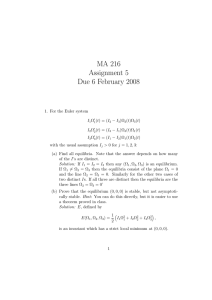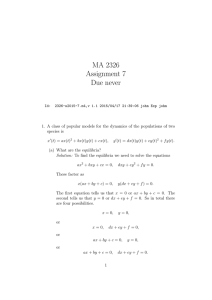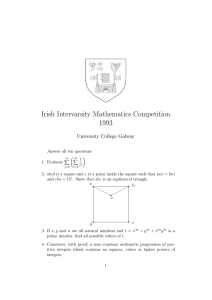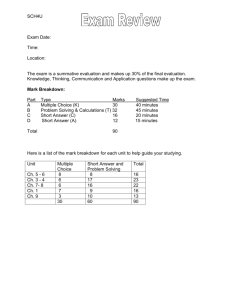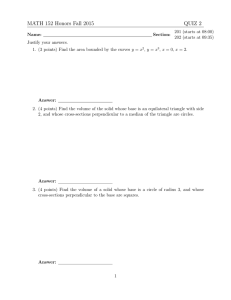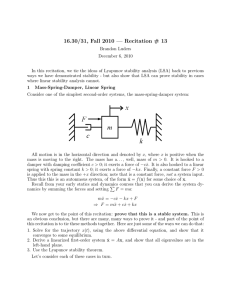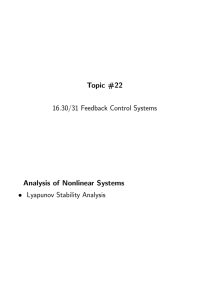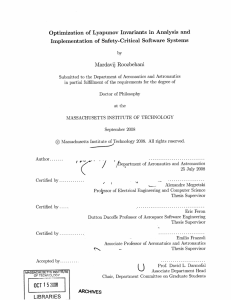MA 216 Assignment 5 Due 6 February 2008
advertisement
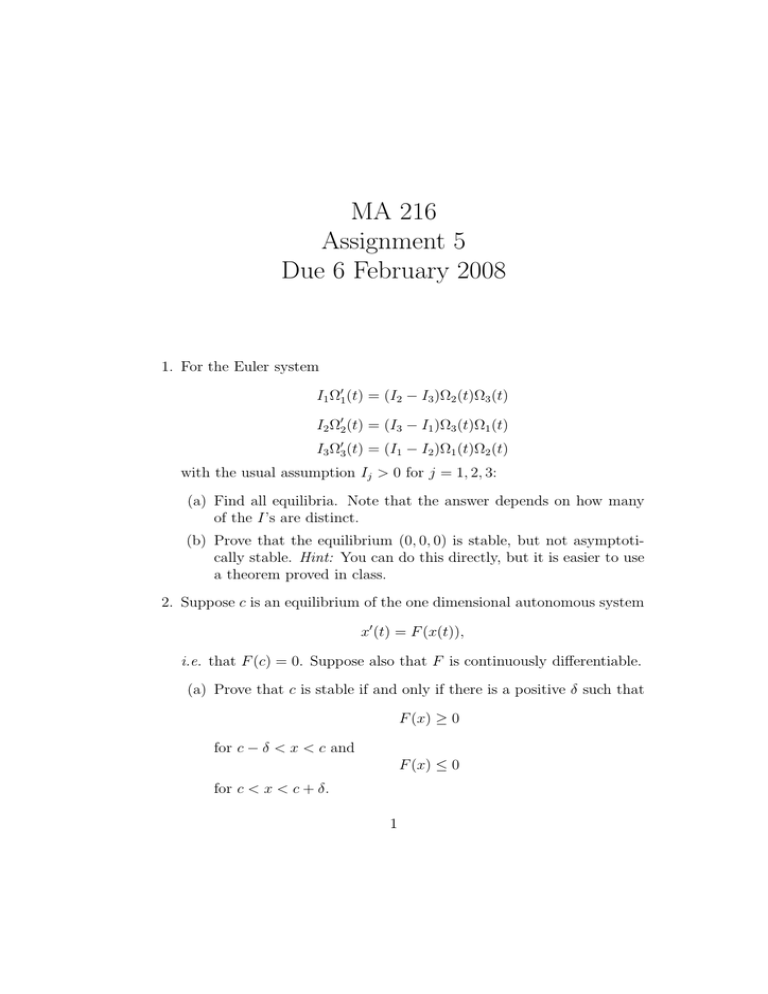
MA 216 Assignment 5 Due 6 February 2008 1. For the Euler system I1 Ω′1 (t) = (I2 − I3 )Ω2 (t)Ω3 (t) I2 Ω′2 (t) = (I3 − I1 )Ω3 (t)Ω1 (t) I3 Ω′3 (t) = (I1 − I2 )Ω1 (t)Ω2 (t) with the usual assumption Ij > 0 for j = 1, 2, 3: (a) Find all equilibria. Note that the answer depends on how many of the I’s are distinct. (b) Prove that the equilibrium (0, 0, 0) is stable, but not asymptotically stable. Hint: You can do this directly, but it is easier to use a theorem proved in class. 2. Suppose c is an equilibrium of the one dimensional autonomous system x′ (t) = F (x(t)), i.e. that F (c) = 0. Suppose also that F is continuously differentiable. (a) Prove that c is stable if and only if there is a positive δ such that F (x) ≥ 0 for c − δ < x < c and F (x) ≤ 0 for c < x < c + δ. 1 (b) Prove that c is asymptotically stable if and only if there is a positive δ such that F (x) > 0 for c − δ < x < c and F (x) < 0 for c < x < c + δ. 3. Find a strict Lyapunov function for the equilibrium (0, 0) of the system x′1 (t) = −x1 (t) x′2 (t) = −x1 (t) − x2 (t) Hint: From lecture you know that there is a strict Lyapunov function which is a quadratic polynomial. In fact there are many and you should be able to find one by trial and error. 4. For equilibrium θ = 0 of the damped pendulum lθ′′ (t) + 2γθ′ (t) + g sin(θ(t)) find a strict Lyapunov function assuming that l, γ and g are all positive. Hint: From lecture you know that there should be a quadratic polynomial which is a strict Lyapunov function for both the original nonlinear equation and it’s linearisation. 5. The restricted three body problem in Celestial Mechanics is that of the motion of three bodies in a plane subject to Newtonian gravitational forces, subject to the additional restrictions that (1) the third body is of neglibible mass and (2) the first two bodies are in uniform circular motion. The relevant system of ordinary differential equations is x′ (t) = ωy + u y ′ (t) = −ωx + v Gm1 (x−ξ1 ) u′ (t) = − [(x−ξ 2 2 3/2 − 1 ) +y ] Gm1 y ′ v (t) = − [(x−ξ1 )2 +y2 ]3/2 − Gm2 (x+ξ2 ) [(x+ξ2 )2 +y 2 ]3/2 Gm2 y [(x+ξ2 )2 +y 2 ]3/2 + ωv − ωu The variables x and y give the position and u and v the velocity of the thrid (massless) body with respect to axes rotating with the first two (massive) bodies. m1 and m2 are masses of the first two bodies and ξ1 2 and ξ2 their distances to the origin, which is located at the centre of mass of the system. G is Newton’s gravitational constant and ω is the angular velocity of the two massive bodies. These numbers are related by G(m1 + m2 ) ω2 = (ξ1 + ξ2 )3 and m1 ξ1 = m2 ξ2 . You can now, if you wish, forget everything in this paragraph except the equations. (a) Lagrange showed the only equilibria of the system are i. All three masses are collinear, i.e. y = 0. There are several possible values of x. All of these are easily seen to be unstable by consideration of the eigenvalues of the the corresponding linearised problems. ii. The three masses occupy the three points of an equilateral triangle, i.e. x= ξ1 − ξ2 2 y=± ξ1 + ξ2 √ 3. 2 Verify Lagrange’s claim that the equilateral triangle configurations are equilibria. (b) Verify that the function H(x, y, u, v) = u2 + v 2 Gm1 Gm2 −ωxv+ωyu− q −q 2 (x − ξ1 )2 + y 2 (x + ξ2 )2 + y 2 is an invariant. Hint: The system can be written in the simpler form ∂H x′ (t) = (x(t), y(t), u(t), v(t)) ∂u ∂H y ′(t) = (x(t), y(t), u(t), v(t)) ∂v ∂H (x(t), y(t), u(t), v(t)) u′ (t) = − ∂x ∂H v ′ (t) = − (x(t), y(t), u(t), v(t)) ∂y 3 (c) Show by means of the second derivative test that the function H has a strict local minimum at the equilateral triangle configurations if (m1 + m2 )2 > 27 m1 m2 and hence, by the theorem from lecture about invariants and stability, these equilibria are stable, but not strictly stable. (d) Show that if (m1 + m2 )2 < 27. m1 m2 then the linearisation about the equilateral triangle configurations has at least one, in fact two, eigenvalues with positive real part, and hence is unstable. 4
